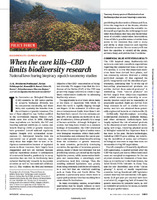When the cure kills—CBD limits biodiversity research : national laws fearing biopiracy squelch taxonomy studies
Date
2018-06-29Author
Divakaran Prathapan, Kaniyarikkal
Pethiyagoda, Rohan
Bawa Singh, Kamaljit
Raven, Peter H.
Rajan, Priyadarsanan Dharma
Metadata
Show full item recordAbstract
The Convention on Biological Diversity (CBD) commits its 196 nation parties to conserve biological diversity, use its components sustainably, and share fairly and equitably the benefits from the utilization of genetic resources. The last of these objectives was further codified in the Convention's Nagoya Protocol (NP), which came into effect in 2014. Although these aspirations are laudable, the NP and resulting national ambitions on Access and Benefit Sharing (ABS) of genetic resources have generated several national regulatory regimes fraught with unintended consequences (1). Anticipated benefits from the commercial use of genetic resources, especially those that might flow to local or indigenous communities because of regulated access to those resources, have largely been exaggerated and not yet realized. Instead, national regulations created in anticipation of commercial benefits, particularly in many countries that are rich in biodiversity, have curtailed biodiversity research by in-country scientists as well as international collaboration (1). This weakens the first and foremost objective of the CBD—conservation of biological diversity. We suggest ways that the Conference of the Parties (CoP) of the CBD may proactively engage scientists to create a regulatory environment conducive to advancing biodiversity science.
Collections
The following license files are associated with this item:




